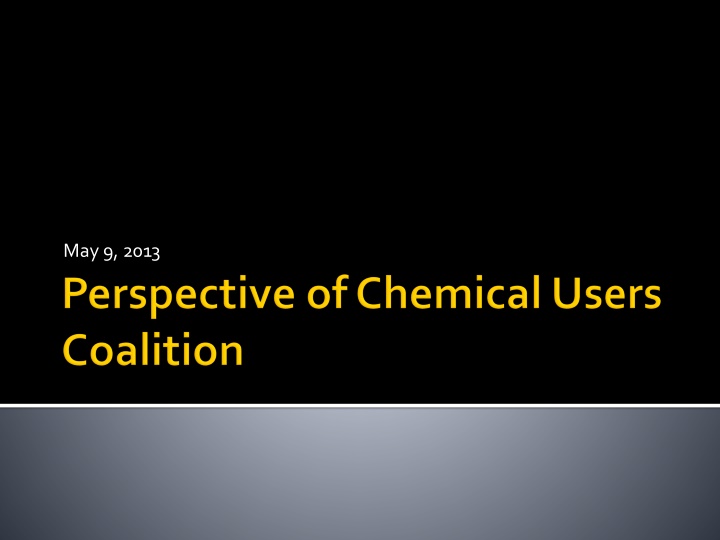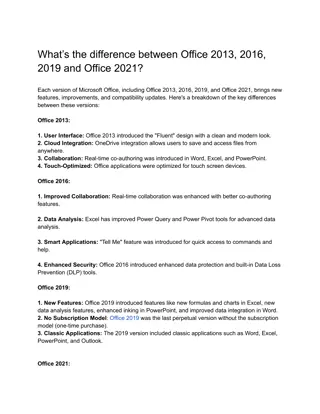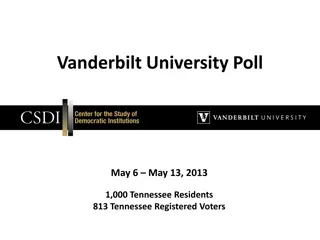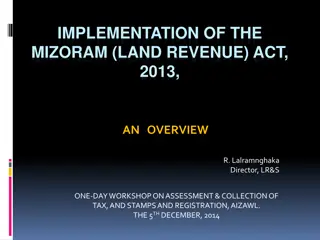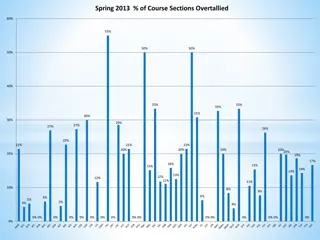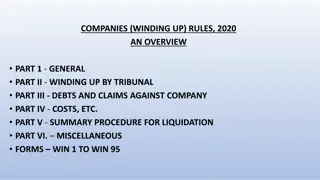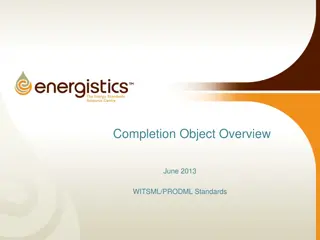May 9, 2013
A coalition representing downstream industries' perspective on chemical management since 2010, focusing on aligning innovation with environmental protection. Discusses positive elements of EPA's chemical program, the need for maintaining agenda consistency, and suggestions for the existing chemical process.
Download Presentation

Please find below an Image/Link to download the presentation.
The content on the website is provided AS IS for your information and personal use only. It may not be sold, licensed, or shared on other websites without obtaining consent from the author.If you encounter any issues during the download, it is possible that the publisher has removed the file from their server.
You are allowed to download the files provided on this website for personal or commercial use, subject to the condition that they are used lawfully. All files are the property of their respective owners.
The content on the website is provided AS IS for your information and personal use only. It may not be sold, licensed, or shared on other websites without obtaining consent from the author.
E N D
Presentation Transcript
Profile of Chemical Users Coalition Perspective on Recent EPA Initiatives Chemical Action Plans and WorkplanChemicals ChemView Information Portal Transparency Projects Recent GAO Report Downstream Industry TSCA Issues Longer-term Policy Interests
Formed in 2010 to represent a critical downstream perspective on chemical management Manufacturing operations not retailers, service providers or brand names without domestic manufacturing Mix of companies across industries find common ground Limited membership, but major industry leaders 8 companies; almost $600 B in global sales Aligning ability to innovate with environmental protection is common theme of activities Will engage EPA, Administration, Congress as needed
Positive elements of new existing chemical program Having an agenda Action Plan, Workplanlist Provides greater certainty for planning purposes We need reliable expectations over 5+ year timeframes Agenda appears calibrated to what EPA will do Appears to match EPA intent, resources, capabilities Good to avoid menu lists that go beyond program s abilities Ex: EPA National Priority List, TSCA Master Testing List, ChAMP concept Such lists are less valuable for planning, stewardship activity Initial assessments have targeted scope Areas of potential risk where TSCA might be able to fill a gap Provides early signal of relevance to downstream industries
Important to maintain agenda over time Establishes program consistency and continuity Concern: recent change in agenda for 2013 assessments Does it signal ongoing annual shifts in agenda? Does it return to TSCA history of unpredictability? Process suggestions Identify early point of contact for individual assessments Would allow for direct communication, information flow Identify steps in existing chemical process What follows screening assessments? Points of public comment, interaction?
Defining Uses in Screening Assessments Use as end-use applications preferred approach Example: paint strippers for NMP, methylene chloride Facilitates exposure assessment, identifying management options Use as a general chemical function less desirable Example: fire retardant category is a functionthat is desired for a variety of materials in a variety of technical applications Specific applications determine likely exposures; technology of applications determines practical choices Evaluation of non-substitution technology options? Engage industry on design, exposure control options
Priority issue: approach to articles under TSCA Article regulation should not be a default approach As a general matter, articles are not the main business of TSCA But targeted article regulation may be needed in some cases Determinations that should precede article regulation Cannot address objective by regulation of substances/mixtures Clear nexus between article and U.S. exposures causing risk Articles of concern likely to be distributed in the U.S. - Implementation issues for articles need greater clarity - Clarify use definitions; example of consumer use confusion - Reasonable screening measures for chemicals in articles?
ChemView Information Portal First reaction is very positive Regulatory information addresses a key downstream concern Access to TSCA data helps chemical evaluation activities Priorities for inclusion in site Include all TSCA requirements, including export and Section 8 Presence on Inventory, with CAS, PMN, Accession identifier Allow for searches by PMN number, Accession number Indicator of pendingSNUR (with planned restrictions) Include proposed rules ability to comment + direct impact Sunset dates for data submission, link to data submitted
Issues to address in ChemView development Data quality: EPA assessments Mix of documents with different purposes, developed over time, based on evolving sets of underlying data Consider ways to assure users see best available data Dates on assessments, sequence documents so best available data must be viewed first, pop-up notices about existence of more recent information CBI concerns will arise with additions and information links Need process for stakeholder vetting to address any CBI issues Ongoing beta testing of site with general public Site holds very useful information, but it is complex Understanding public use, reaction can guide better design
Transparency Initiatives As users of chemical data, we appreciate effective access to information; but we also know that CBI protection is essential for us to be competitive B to B data-sharing vs. public domain information is a key issue Favor approach emphasizing effective system for case by case CBI claims; most adaptable to the many contexts where competitive intelligence challenges arise Adding rigor (e.g., upfront substantiation) may be needed Mandatory disclosure provision raise more concerns, particularly when EPA expands interpretation of key terms (e.g., health and safety study) to include process and chemical function data
Perspective on protection of R&D information Chemical ID should be protectable, if substantiated Low exposure to public; less compelling disclosure need CBI value is at its highest; provides roadmap to innovation This pattern can reverse at commercialization stage But that depends on specifics of chemical and technology Can be sorted out in case by case CBI determinations Perspective on protection of mixture information Toxicity testing of a mixture has limited value to users Important if mixture is used, but B to B sharing is often adequate Generally don t rely on such tests to evaluate constituent toxicity
Recommendations on Transparency Policies Case by case CBI determinations are preferred Processors, users should be allowed to participate in CBI claim and appeal process for use/exposure information Upstream chemical producer may not be party in interest Protecting chemical identification at R&D stage is critical Protecting names of chemicals in a mixture when a mixture is tested should be allowed Engage stakeholders on value of data to be disclosed Assumptions about value of data may be inaccurate
Support Agency response on Processor Reporting Mirrors comment CUC filed on CDR rule Processors may hold key information on exposure, but the context determines when they are the best source Factors include EPA data needs, length of supply chain, number of parties at each step, sophistication of parties, existing industry networks for sharing data, experience with EPA collaboration Obtaining more detailed exposure data beyond CDR is best accomplished through a case by case approach Possibly by industries, product categories, pathways for release to the environment, specific geographies Where feasible, voluntary action tends to be timely and effective
TSCA impact on downstream industries Regulation as processors, importers, exporters, etc. But dependent on suppliers for chemical-specific information Supplier compliance issues can disrupt operations Challenge: TSCA applicability to materials supplied Often provided materials that are mixtures or are identified by names not used in TSCA rules CAS number ID vs. PMN numbers (in SNUR) MSDS chemical names vs. TSCA substance names Proprietary chemical ID information masked by suppliers
Supplier notice about TSCA obligations is uneven More consistency on TSCA Inventory status SNUR, reporting obligations not always noted Particularly when supplier is distributor/broker Long lag times for public notice about SNURs Recent EPA actions have included PMN s filed in 1990 s Some chemicals have been in commerce for several years before downstream companies learn of SNUR Direct final process creates a narrow window to respond
TSCA rules do not offer effective pathways to determine what TSCA rules apply to a chemical Bona fide request process is too slow and requires unrelated information (e.g., filing date for PMN) SNUR safe harbor provision (721.5(c)) is not useful; requires companies to document lack of knowledge that a SNUR applies; document that you don t know? CUC polled members on most effective approach Top priority: online check of regulatory status, by chemical Direct alignment with capability of ChemView, so ongoing CUC interest in developing site to support compliance
Additional measure that would be helpful Export notification: posted updates on chemicals covered Identify changes since prior update Issue SNUR actions on a more timely basis Bona fide request tailored for processors Would be used mainly for R&D purposes for chemicals not yet in commerce (prior to Notice of Commencement) Request would be to determine whether the substance is facing controls (e.g., restrictions on use, volume, discharge to water) Certification of intent to process (not manufacture) submission Update training materials for importers (e.g., CDR role) Consider translation to assist global supplier networks
Speed to market (efficiency in new chemical review) Critical need to maintain global competitiveness Concerns about policy/resource changes that affect speed Interested in any streamlining efforts Consistency of policy, information across borders Global companies facing diverse regulatory systems US should not defer to policies that are not risk-based But opportunities for practical alignment of standards exist Mutual acceptance of data and assessments are also possible Similar need to align across state borders
